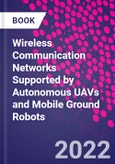Wireless Communication Networks Supported by Autonomous UAVs and Mobile Ground Robots covers wireless sensor networks and cellular networks. For wireless sensor networks, the book presents approaches using mobile robots or UAVs to collect sensory data from sensor nodes. For cellular networks, it discusses the approaches to using UAVs to work as aerial base stations to serve cellular users. In addition, the book� covers the challenges involved in these two networks, existing approaches (e.g., how to use the public transportation vehicles to play the role of mobile sinks to collect sensory data from sensor nodes), and potential methods to address open questions.
Please Note: This is an On Demand product, delivery may take up to 11 working days after payment has been received.
Table of Contents
1. Introduction 2. Survey of approaches for wireless communication networks supported by ground robots 3. Wireless communication networks supported by autonomous UAVs:�A survey 4. Data collection in wireless sensor networks by ground robots with full freedom 5. Data collection in wireless sensor networks by ground robots with fixed trajectories 6. Energy-efficient path planning of a solar-powered UAV for secure communication in the presence of eavesdroppers and no-fly zones 7. Multiobjective path planning of a solar-powered UAV for secure communication in urban environments with eavesdropping avoidance 8. Reactive deployment of UAV base stations for providing wireless communication services 9. Optimized deployment of UAV base stations for providing wireless communication service in urban environments 10. Energy-efficient path planning of solar-powered UAVs for communicating with mobile ground users in urban environments








